Physically light, Libertad, Igualdad, Fatalidad (2016) is not underweight on ambition or conceptual ballast. Its creator, Chilean artist Claudio Correa, installed a real-scale brigantine in the hall of his country’s National Museum of Fine Art, with neither a hull nor a deck: a half-visible ship out of water, at full sail in a hallowed institution. He engineered this site-specific work to reflect on Chile’s deeply-rooted migratory problems, historical debts, and struggles for national identity. This is an invitation to a trip through American history, and the roots of Chile’s present-day social and political crises. The sails billowed in an artificial breeze created by a fan system whose intensity was controlled by the volume of an accompanying audio recording. The swelling voices filling the sails belonged to three South American immigrants to Chile – from Venezuela, Peru, and Colombia. Each sang Spanish versions of the French hymn La Marseillaise, three adaptations of a chauvinist anthem repurposed by anti-imperialist political movements. Correa had previously worked with these elements in Cuatro formas de ser republicano a distancia (“Four Ways to Be a Long-Distance Republican”), 2013, an 8mm short film in which characters played translated versions of La Marseillaise while their wax instruments gradually melted. The theme was similar: the ideological deviation between the original anthem and the Latin adaptations. But this time, Correa is inviting us to climb to the top of the main mast and spy on the horizon. Do we descry any land?
Some small technical elements need improvement: the fans are too visible, too small, too ugly; the show’s titular parody of the French Revolution’s famous “liberté, égalité, fraternité” perhaps too on-the-nose. But in its major aim, this installation is a success, providing timely, historically-rich perspective on the country’s largest current concerns. In many respects, the issues countenanced by Correa’s ship (immigration, identity, assimilation) are familiar in other parts of the world, but Chile’s own particular history is crucial here.
So, here, I disguise myself as a stowaway to reveal some of the secrets imbedded in this nautical environment.
The groundswell. It’s no accident that Correa’s brigantine is based on a model from the XIX century. The Republic of Chile was founded after its independence from Spain in 1818. At that time an afrancesada –“frenchified” – aristocracy was more sympathetic to European sentiments than to the autochthonous. In 1845, the Chilean National Congress passed the so-called Colonization Law: a “passport” for more than 3000 German families to settle in the south of the country, on lands that belonged to Indigenous peoples. This is the main antecedent of the present Mapuche Conflict: today this same Indigenous population is struggling to reclaim old properties from the descendants of German settlers. The Colonization Law had other objectives as well: chiefly, the imposition of a European model of progress and modernity upon (as one Southern aristocrat put it) “an association of barbarians […] nothing but a horde of beasts that must urgently be chained or destroyed in the interest of mankind and for the good of civilization.”
In the basement of the museum lies a series of photographs of the Patagonian Indigenous, as well as a video capturing a family of their (very remote) descendants manufacturing a canoe. Native tribes such as this were exterminated, often at the hands of European “human hunters” who sold their ripped-off heads as curios to similar-looking museums back home, in “civilization.” Nowadays, Indigenous people represent only about 8% of Chile’s population.
The wake. The main floor of the museum is not only occupied with the brigantine. It also contains an exhibition of sculptures from the permanent collection. Among these are reproductions from European Classic Antiquity that have long been used as models for students at the Chilean Fine Arts Academy. The Academy, created in 1849, imported its aesthetic ideals and professors from Europe. Insofar as Correa’s ship is meant to play on the local imitation of European ideas, it’s very fitting that these teaching tools should sit in its wake.
The hull. The mast and poles that connect the sails sit suspended in thin air, above the polished floor. There is no visible hull. The absence of the structure is an allegory for Modernity’s failure to arrive. Despite the voyage’s itinerary, plotted with waypoints from the French Revolution and European Enlightenment, the ship never fully materialized at port. Not social welfare; not protection against tyranny; not cultural elevation of the population; nothing more than flags and sails blowing in a welter of translated song. Despite the familiar tune of the echoed hymns that drive the ghost vessel, nothing like freedom, equality, or fraternity fills these sheets.
The sails. In Chile the 1975 Law of Foreigners and Migrations, a relic from the dictatorship, is still in force. Though the law retains many outdated and politically vindictive restrictions, attempts at revision are perpetually postponed in Congress due to budgetary problems. By the way, the dictator, Augusto Pinochet, has French roots that goes back to the arrival of the merchant Guillaume Pinochet in 1720 to Chile (in a brigantine?).
Meanwhile, complaints from would-be immigrants rejected at the Chilean border increase in pace with the newcomer population within. In 2014, the immigrant population represented 2.48% of the population. This year, that figure has risen to 6.63%. The specter of economic immigration raises the worry and ire of the elite, a smallish group of privileged individuals who preserve colonial European surnames (despite many decades of intermarriage and naturalization).
The voices of Venezuelan, Peruvian, and Colombian immigrants swelling the ship’s sails are a symbol for a low-income American immigration attempting to emulate the precedent of high-income trans-Atlantic colonization: all under the watchful eye of a wealthy class who believe themselves to be more European than they actually are.
One of this year’s literary revelations, Pablo D. Sheng’s novel Charapo, describes Recoleta, the most multicultural neighborhood of Santiago, where the overcrowded and speculation-menaced live, selling products on the streets in front of dilapidated houses with Continental façades. Perhaps it is from here that the sails’ spectral voices emanate.
Passing in the night. Photographer Jorge Brantmayer also recently turned his attention to Chile’s unequal globalization. For his ongoing 2016 exhibition, Muchedumbre: Geografía de la piel (“Crowd: The Skin’s Geography”), he photographed the faces of a series of foreigners, mostly Haitians, in black and white. There are no gestures, no smiles. The images feel like large-scale ID cards, a collective portrait of a part of society that remains at best unknown – at worst disregarded – by the upper class. Pointedly, the exhibition is showing at CorpArtes gallery, located in an exclusive neighborhood of the capital city: an opportunity for dialogue between two communities that seldom interact, although both have their roots outside the country.
These superimposed worlds were tellingly illustrated in a recent special edition of Paula, a national trend magazine. Dedicated to immigration and entitled “Chile Changes its Skin,” the volume placed four Afro-American models on the cover. Inside, however, advertisements for clothes and perfume featured familiar, mostly Caucasian models. At the end of the magazine sat the untouchable “social pages,” a section with photographs of the Chilean high-class: blonde, blue-eyed happy people with European surnames. “Progress” insists on a certain tone.
The skies. The mast of the brigantine almost touches the ceiling of the museum. This building, with its Art Nouveau decoration, is based on the Petit Palais of Paris. During its inauguration in 1910, and in commemoration of the centenary of the country’s independence, a new national anthem was debuted: “How pure, Chile, is your blue sky / And how pure the breezes that blow across you / And your countryside embroidered with flowers / Is a wonderful copy of Eden.” As though the highest ideal to which Chile could aspire – the purest blue conceivable – remains but a wondrous facsimile.
Mutiny. The National Museum was conceived as a vessel for grand dreams of Progress and Modernity. In 1922, a sculptural set of Icarus and Daedalus was installed out front, with an inscription on a stone pedestal reading: “United in glory and death.” Nearly a century later, the workers of the museum don’t seem to agree. Intermittently, since last year, visitors have encountered a new epigraph at the entrance: “Museum on strike.” Synecdoche, or no? As employees struggle to attain fair working conditions, it’s tempting to wonder whether the Greek heroes and lofty Enlightenment ideals of the institution might not also file grievance, and join the picket over promises unfulfilled.
The course. Neither the curator of this installation, Sebastián Vidal, nor the artist himself, makes a statement regarding where they think this ship is heading. With the incremental growth of the immigrant population, without revision of the present law, and with the likely re-election of the right-wing former Chilean president Sebastián Piñera, strong tides are expected.
Claudio Correa’s work, through the dematerialization of the body of a great ship, makes visible a multifaceted structure that helps us understand Chilean identity and its contradictions: the historical roots that stage the chase for an alien “European Dream,” and predetermine prejudice and grim prospects for newcomers. While Correa tells Chile’s story, in truth, Freedom, Equality, Fatality’s sense of broken promise and absconded modernity is increasingly shared by all the nations of America.

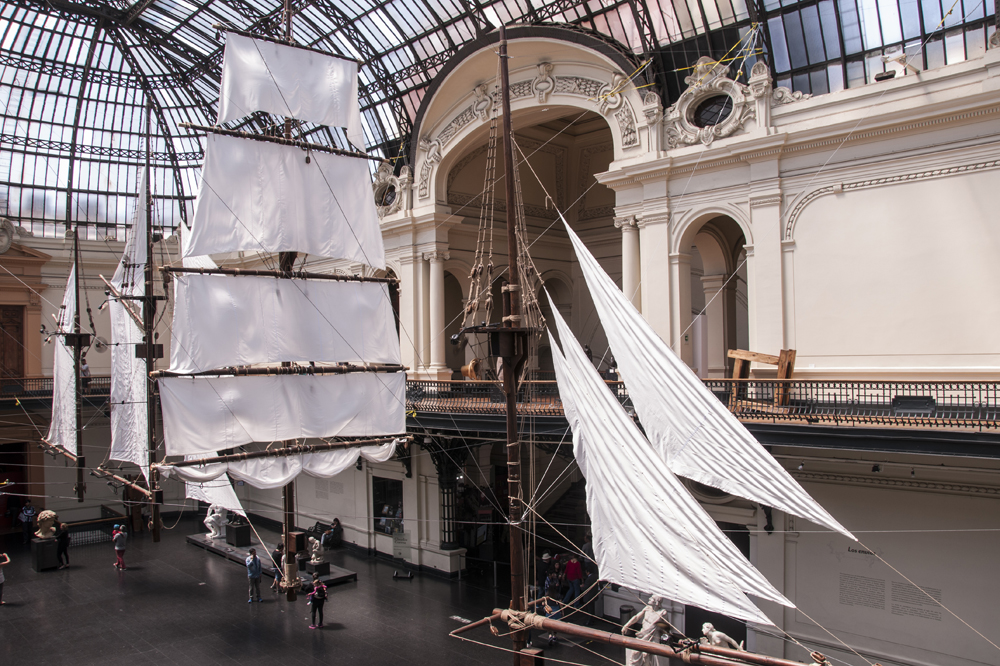
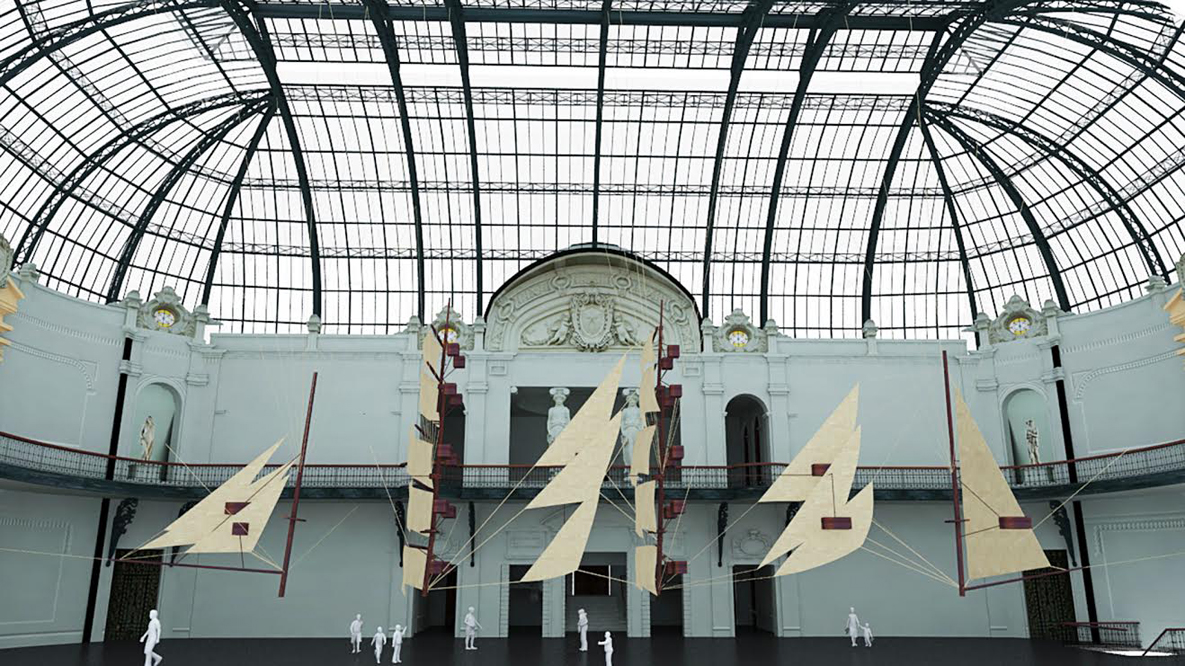
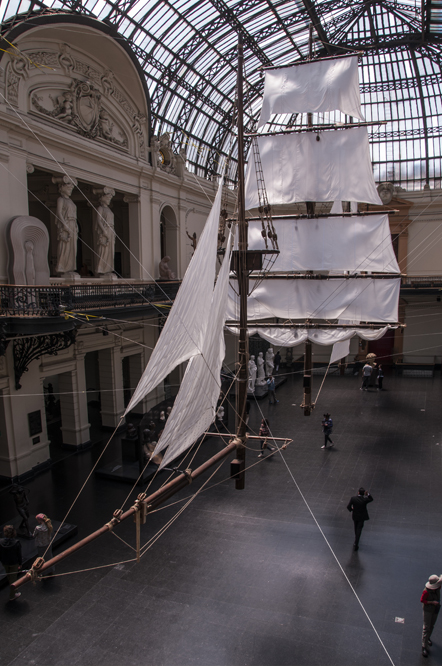
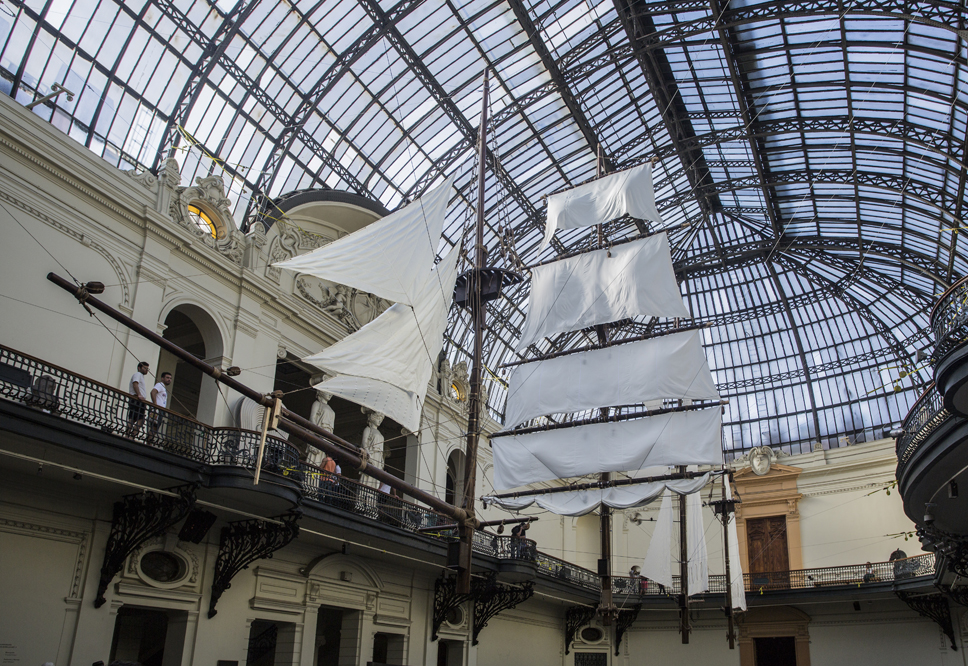


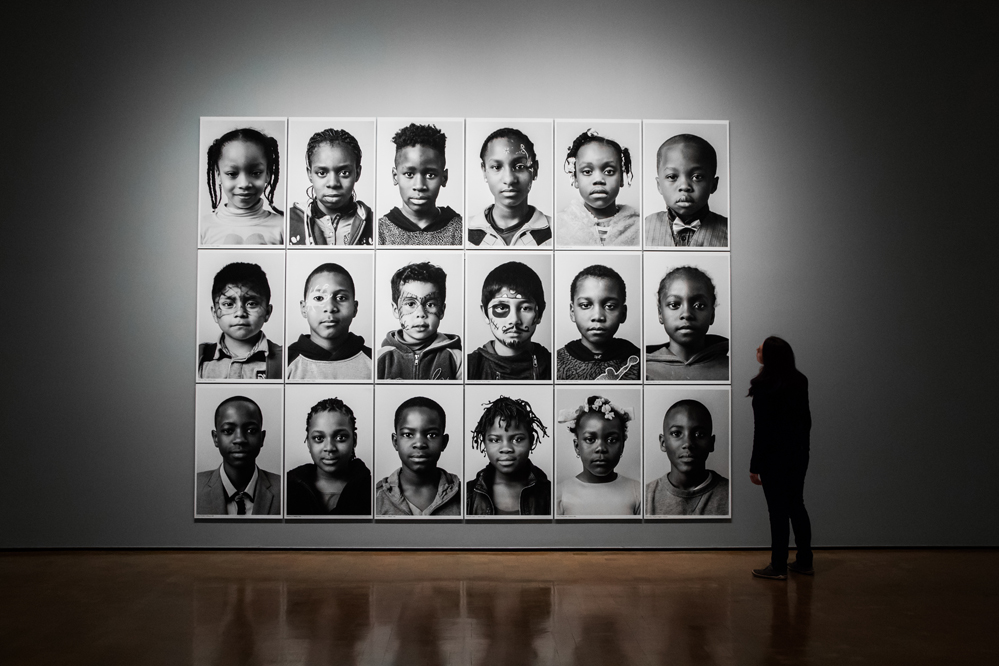




















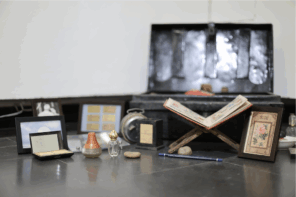
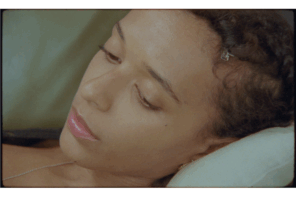


1 Comment